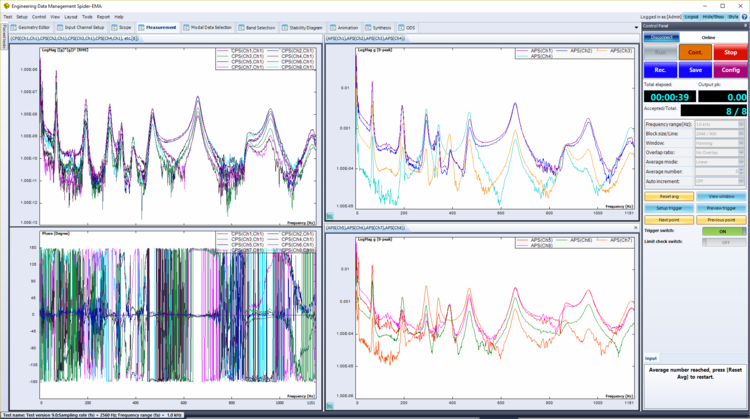Operational Modal Analysis
Experimental modal analysis (EMA) is based on forced excitation tests during which Frequency Response Functions (FRFs) are measured. However, real world loading conditions often differ considerably from those used in lab testing. Since all real-world systems are to a certain extent non-linear, the models obtained under real loading will be linearized for much more representative working points. Additionally, environmental influences on system behavior, such as pre-stress of suspensions, load-induced stiffening or aero-elastic interaction, will be taken into account.
For many cases, such as bridges under traffic/wind excitation, forced excitation tests are very difficult to conduct when using standard testing equipment. In such situations, operational data is often the only type of data that is obtained.

Many of these structures are under some external uncontrollable ambient forces which causes them to vibrate. Since these forces in general cannot be measured, it is impossible to apply the Experimental Modal Analysis techniques that rely on the estimation of the Frequency Response Function. The only data that can be obtained from an operating structure are the responses due to unknown ambient excitation forces. These responses are typically measured in several positions which are referred to as the Degrees of Freedom (DOF), which is carried out the same way for EMA testing. It is in these points that the modes shapes are determined.
The availability of an operational model opens the way for in-situ model-based diagnosis and damage detection. Hence, a considerable interest exists in extracting valid models directly from the operating data. This develops into the Operational Modal Analysis (OMA).
OMA Data Acquisition and Processing
There are two intuitive methods to acquire the responses needed for Operation Modal Analysis. These methods are Single Run Test and Multiple Run Test.
Single Run Test
There are situations where it is undesirable to move around with sensors. In such cases, sensors are placed in a Single Run Test setup. This approach is utilized for permanent monitoring systems, for cases in which measurements cannot be repeated, or to simply save test time.
Multiple Run Test
There are many situations in which the sensors are moved around from one set of positions to another. This is defined as a Multiple Run Test setup measurement procedure.
In this case one or a few high-quality sensors are placed in positions where the modes of interest receive a good response level. These sensors are called reference sensor(s) and are fixed in the same position when moving from one test setup to another. The rest of the sensors are placed in the DOF positions where mode shapes are desirable.

The reference sensors stay in the same positions while repeatedly measuring the mode shapes. Since the mode shape part should be the same from one test setup to the next, it provides a way to scale the rest of the mode shape values for different runs of test setups. Normally, the adjustment is performed with some least squares fitting technique to utilize the multiple references available.
For any set of measurement data, one or more response channels will be set as reference, and the cross-power spectrum will be calculated.
Operational Modal Analysis Algorithms
The purpose of this procedure is to extract modal parameters from data acquired under operating conditions. This means it is under the influence of its natural excitation such as airflow around the structure, traffic on the bridges, internal excitation of rotating machinery.
The Operational Modal Analysis module is aimed specifically at applications where the inputs (Excitations) cannot be measured and works only when responses such as accelerations signals are available. The ideal situation is when the input has a flat spectrum.
The classical modal analysis methods applied on FRF sets can be adopted directly to process the corresponding CPS signals to yield the modal parameters (e.g., Natural Frequencies, Damping ratios, and Mode Shapes).
Some parameter identification methods were developed specifically for OMA. These are: Frequency Domain Decomposition (FDD) and Enhanced Frequency Domain Decomposition (EFDD). The foundation of these methods is Singular Value Decomposition, and these are equivalent to Complex MIF. The peaks of singular value signals are considered the modes. That is the reason they are also referred to as the peak-pick method. Stochastic subspace identification (SSI) is another popular method to process the OMA data set.
